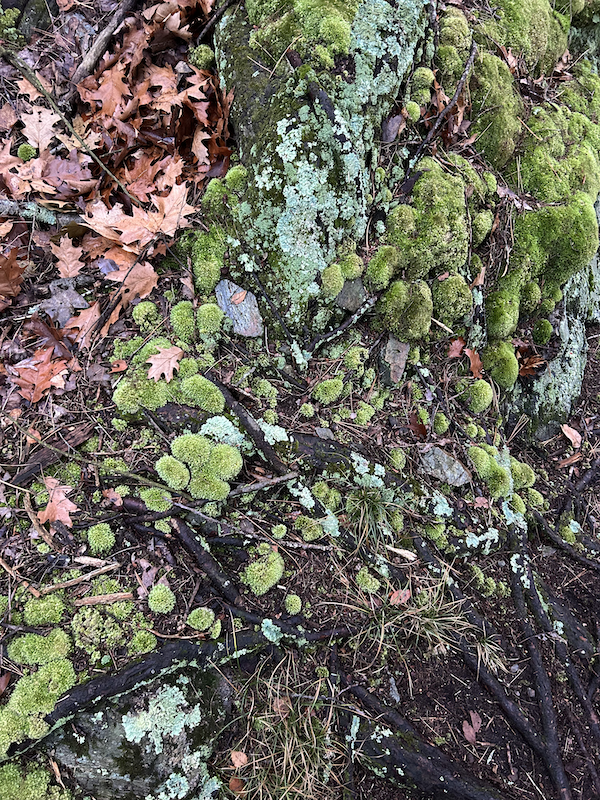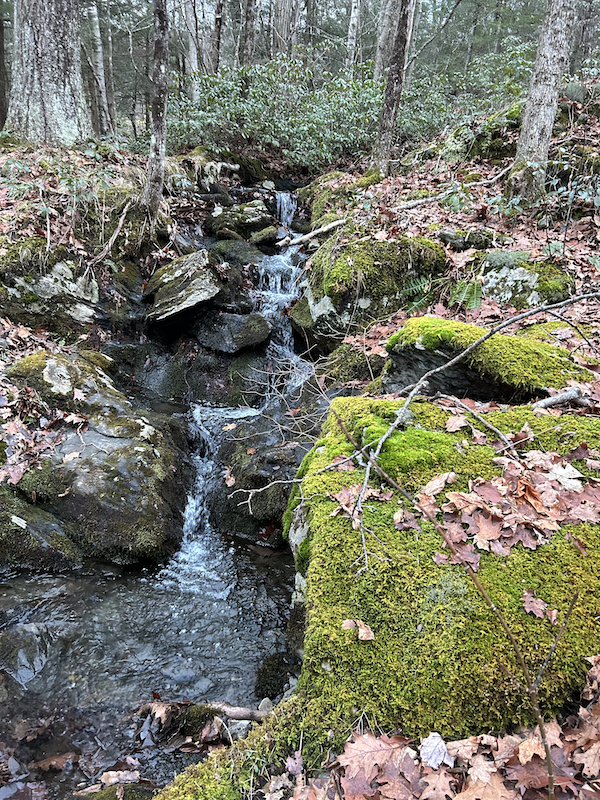Happy New Year, and welcome back to Yield Guide.
A bit of housekeeping—I’ve recently switched platforms; this letter series is now hosted on Buttondown, which accounts for the slightly different look of these emails. If you’re a paid subscriber, you won’t have to do anything on your end, but let me know if there’s a hiccup and you get double-charged, or if your access to paywalled posts isn’t going through. For those of you new to this letter series, you can find the archives of Yield Guide at: buttondown.email/yieldguide. Thank you so much for continuing to read and support this project in slow looking.
A thing I love about living in the country is how near it has drawn me to the natural world. It’s impossible to ignore the way the seasons pass here. The change shows on the landscape, how the mountains go from massed dark green to red and gold to lacelike and airy in winter, nearly immaterial. In this season the sky looks larger, grayer; the exposed shape of the earth is more prominent without the lush verdance of spring and summer to fill it in. Bodies of water stand out in this starkness, seem to sparkle. Depending on the light they look both bright and dark. A pond has formed in the field where cows pasture across from my house. When I hike, I can see through the trees.
In the absence of the deciduous leaves of the forest and the ground cover, which has mostly gone dormant in the cold, I’ve been noticing mosses and lichens. I’ve been taking photographs of the arrangements they make—arrangements is an odd word; so is formations; really I just want to say paintings—on the sides of rocks and the bases of trees.
The different shapes and textures, the brilliance of green on gray. There’s a vibrance to these mosses and lichens that I didn’t notice in the previous seasons, where there were so many other places to look.

In therapy one morning, I say: I want to begin to notice when a feeling feels like home, and why it feels that way.
I don’t mean the good, warming, loving kind of feeling like home, like when a place or a person feels like home, but the other way of feeling like home. When my mind slips into the well-worn groove of a thought I’ve thought for so long it’s become intrinsic to my personhood.
Like when I think: This wound feels like home; I will make my home in this wound.
A few days earlier, settling onto the meditation cushion, I’d caught myself simultaneously settling into a place of doubt and pain. Sinking into it like I would a comfortable chair, into a pain that felt sweet and comfortable and familiar. Because it synced so neatly with my physical movement, and because I was preparing to meditate, my awareness a little bit more heightened, a little bit more open, I noticed it. I noticed how I wiggled into it, embraced it, got ready to literally sit in it for thirty minutes.
Once I noticed it, I asked myself why I feel that way. Why that place feels like home.
*
I’ve been really tender lately. Porous, maybe, is another good word for it. The last two years have been ones of massive change. I began a new relationship, I stopped drinking, I finished grad school, I started teaching, I moved upstate. In the times of most intense flux, I felt myself strengthening, turning flexible and brave. But in the moments of stillness—particularly, for some reason, in this transition between years—I have felt both an expansion and a surfacing. As though something is coming into view.
Mosses are different from lichens; the latter are a symbiotic mingling of algae and fungus. The fungus provides the structural body of the lichen while the algae allows it to photosynthesize. But lichens are an oddity, largely unrelated to the kingdom Plantae. Mosses, by contrast, are considered to be the living ancestors of all other plants. They photosynthesize and absorb nutrients through their small, simple leaves; without a vascular system or flowers, they root readily in porous surfaces and spread easily through spores. The leaves of moss are usually only one cell thick, but that doesn’t prevent them from being structurally interesting. Through a loupe or under a magnifying glass, the humble moss—yellow-green, soft and spongy—reveals itself to be a forest in miniature, with waving fernlike branches and tiny spindly trees.
One thing I’ve learned about noticing: when you start noticing one thing, it lights up a path to all the other connected things.
*
What arises out of stillness? What grows? Today, as I write this, I am happy, safe and loved. I cook. I meditate. I write. I eat. And somehow, in this security, in this valley nestled between mountains, old wounds have come to the surface. They are inside me, where they have always been; it’s only now that they’re making themselves known. No, that’s not quite right: it is this stillness, I understand, that allows me to observe them. To become aware of what they ask of me without reacting in turn.
When I say I’m aware of these feelings—the ways my brain flits back toward that which hurts me—I don’t mean that I am trying to negate or deny them, though I have tried that, and failed. What I am attempting now is to open toward them. For I know that this doubt and fear arises from a place that wants to protect me, and has tried. For I know that however much I mask it, however much I allow myself to pour it out of me, I have trouble letting in love. There’s a part of me—a small part, a big part, a part that was created to protect me—that has her heart closed to vulnerability. That believes I am unlovable. That I’m not worthy.
Can I turn and love that part of me, too? This ancient part of me, cowering in the dark?
*
In Portland for the holiday, my eyes open to the presence of moss, its thickness, its insane green, I see it everywhere, so much so that when I return to the Northeast I miss it for days after. How it clung to branches and bearded the trees.
On New Year’s Day, back upstate, we take a hike up a mountain near where we live. The path up is normal, by which I mean the trees are thin and we can see through and the trail is a little steep but not overwhelming, and on the way up there’s a hunting seat high in a tree that I climb and sit in until I get chills, and below it the remnants of a wasp-nest, papery and light, and by the peak there’s an ocean of reindeer lichen that Rachel leads us to, and then on the way down, weaving back and forth across a stream, I feel that we’re passing through time, walking backwards through centuries.
It’s an older side of the mountain. I don’t know how to explain it. Everything is veiled in green and icicles. Trees slant against the slope, the stream splits; the stony face of the mountain is visible, and it is ancient. We have to cross the water three times. My boots get wet and then they dry. I breathe in great lungfuls of air, stop at every turn, looking, looking. Moss drapes across the rocks; moss trails down from tree roots. Shaggy, feathery, spiky, various. This mother of plants, this old, simple, beautiful green thing.

In Japan, I read, moss is encouraged to grow in some gardens for aesthetic effect, carpeting the ground. It gives spaces an aura of time slowing, of immense quiet and stillness. In Tokyo, wandering into the garden behind the Nezu museum, I encounter a stone statue, a stack of offerings before it, seated on a blanket of moss.
This wound is not my home, I will not make my home in this wound.
There is much to grieve this year. And yet. And yet.
You can use moss for many things—as food, as insulation, as fire-starter, as a sponge that soaks up water.
An image that returns to me often, when I realize that I haven’t been letting in love:
A pail is placed under a spigot, but there’s a hole, low on the body of it, and the water keeps draining out as fast as it can pour in. I imagine filling the pail with sand, with soil, and then finally, with a layer of something soft, lush and absorbent, and then I imagine filling it with water. Every layer drinks it up, holding every drop. The pail grows heavy. That’s the point.
Outside my window, a layer of ice has formed on the cow pond. The sun is just beginning to set; a seam of the palest purple-pink runs along the spine of the mountains. I will stop to watch it, to see the colors change.
Till soon,
LP
PS: My friend Rachel, a herbalist and scent artist, loaned me their copy of Gathering Moss, by Robin Wall Kimmerer, for which I am very grateful; though I wasn’t able to read much of it before writing this letter, I know the text has left its imprint.
You just read issue #13 of YIELD GUIDE. You can also browse the full archives of this newsletter.

Add a comment: